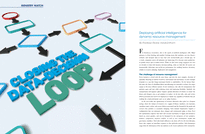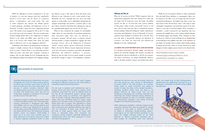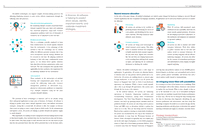By Pradeep Reddy Varakantham
For businesses everywhere, this is the epoch of artificial intelligence (AI). Major
advances in deep learning and machine learning mean that machines can now dissect,
evaluate, and interpret data in ways that were inconceivable just a decade ago. As
a result, companies across all industries are harnessing AI to become more productive,
to predict better and to market better. While we have been using computers for over
six decades to help with business decision-making, today we find that AI systems are
demonstrably delivering state-of-the-art performance for enabling business decisions,
notably in resource planning, deployment and management.
The challenge of resource management
Every business is faced with the most basic, and also the most complex, decision of
optimally allocating its limited resources, both human and non-human, to meet multiple
demands in a way that brings maximum benefit to stakeholders. On the factory floor,
this takes the form of scheduling labour and allocating raw materials to achieve the target
output in the most efficient manner. In the warehouse, this calls for arrangements that
optimise space and time while reducing errors and improving flexibility. Similarly, the
transportation and logistics sphere requires optimal allocation of vehicles to ensure the
fastest and cheapest ways to get products to market. At the last mile, sales and service
delivery personnel also need to be deployed in a similar way, regardless of whether they are
working for a brick-and-mortar store or an online business.
In the real world, this optimisation of resource allocation takes place in a dynamic
setting, where the volume of resources (i.e. supply of labour, machines, raw materials,
warehouse space, trucks, and service delivery personnel) and the demand for the goods and
services they produce is constantly changing. Such dynamic deployment requires a
configuration that can anticipate these changes and continuously adapt to them. Even
this optimisation sequence that takes into account uncertainty in supply and demand is
based on ceteris paribus, and can be disrupted by the emergence of new products,
markets, competitors, business models, as well as new environment, health and
governance mandates. Such adversarial in uences can throw off even the best-laid plan,
hence they require an immediate response to that particular incident. Such disruptions
range from the uberisation of the taxi industry to the recent outbreak of the coronavirus.
Deploying artif cial intelligence for
dynamic resource management.
Bike-sharing in s ingapore
Source: Pradeep Varakantham, “Using Big Data to make bike sharing more effcient”, Today, June 2017.
Where AI fts in
What do AI systems do better? While computers that run
optimisation programmes have been around for a while, and
are being used by businesses across the board, AI-enabled
systems are able to: (1) deal with scale, process millions
of data points within seconds, and provide answers in real
time; and (2) learn from past data to continuously improve
decision-making. Enhanced intelligence enables simultaneous
processing and deployment of tens of thousands of resource
segments under hundreds of scenariosall in real time. They
not only help to dynamically optimise the allocation of
resources, but allow for short-term and medium-term
planning to be done simultaneously.
Closing the loop between data and de Cisions
In a dynamic environment, demand, supply, and adversary
patterns are constantly changing. One moment, you think you
understand the universe and plan for it, and the next moment,
the market environment can change dramatically. Business
today is all about incident response and incident prevention.
Therefore, the second way was conceived, where the
onus was placed on users, instead of intermediaries,
to position bikes in the right locations. An incentive-
based system in which customers were offered a
reward to leave the bikes at the desired locations
meaning locations where there was likely to be
greater demand for bikescould work. The key
challenge in providing such monetary incentives was
balancing the trade-off between being attractive to
customers (leaving the bike at a location desired by
the bike-sharing company) and being fnancially
feasible for the bike-sharing company.
While data-based prediction methods helped predict
consumer demand, they were not suffcient to compel
customers to move bikes to desired locations. The
AI systema data-driven decision-making system
could fgure out the right fnancial incentives to use,
given the multiple scenarios based on the future
demand of rational consumers operating with a
fxed budget. By combining data and decisions
within one closed loop for bike sharing-systems,
performance was signifcantly improved by up to
40 percent, compared to methods using multiple
real data sets.
While the use of enterprise software to collect operational
data and build robust databases is commonplace tod






 분야
분야


